
Saint Dmitry Ivanovich Donskoy was Prince of Moscow from 1359 and Grand Prince of Vladimir from 1363 until his death. He was the heir of Ivan II.
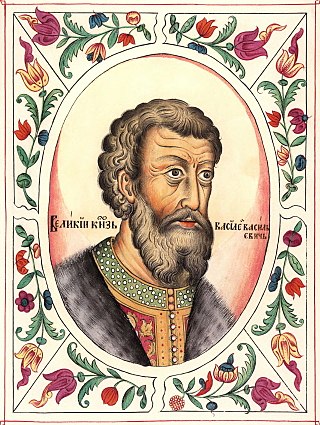
Vasily II Vasilyevich, also known as Vasily the Blind or Vasily the Dark, was a Grand Prince of Moscow in the 15th century. When his father died in 1425, the 10-year-old Vasily and his uncle Dmitry Shemyaka started fighting over the right to the throne, causing the Muscovite War of Succession (1425–1453). At one point, Vasily was captured and blinded by his opponents. Only after winning a decades-long bloody family struggle, during which Ulugh of Kazan captured Vasily and made him his vassal, was his reign finally generally accepted. Due to his disability, he made his son Ivan III his co-ruler in his late years.

Ivan III Vasilyevich, also known as Ivan the Great, was Grand Prince of Moscow and all Russia from 1462 until his death in 1505. Ivan served as the co-ruler and regent for his blind father Vasily II before he officially ascended the throne.
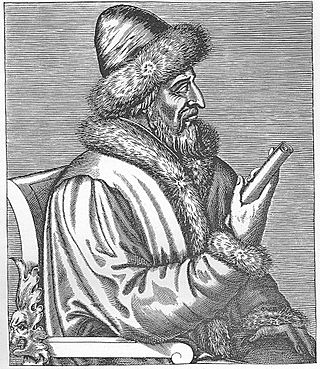
Vasili III Ivanovich was Grand Prince of Moscow and all Russia from 1505 until his death in 1533. He was the son of Ivan III and Sophia Paleologue and was christened with the name Gavriil (Гавриил). He had three brothers: Yuri, Simeon and Andrei, as well as five sisters: Elena, Feodosiya, another Elena, another Feodosiya and Eudoxia.
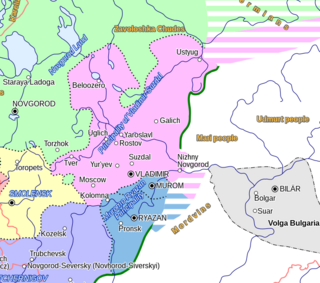
Vladimir-Suzdal, formally known as the Principality of Vladimir-Suzdal or Grand Principality of Vladimir (1157–1331), also as Vladimir-Suzdalian Rus', was one of the major principalities that succeeded Kievan Rus' in the late 12th century, centered in Vladimir-on-Klyazma. With time the principality grew into a grand principality divided into several smaller principalities. After being conquered by the Mongol Empire, the principality became a self-governed state headed by its own nobility. A governorship of principality, however, was prescribed by a jarlig issued from the Golden Horde to a Rurikid sovereign.

The Great Stand on the Ugra River or the Standing on the Ugra River, also known as the Battle of the Ugra, was a standoff in 1480 on the banks of the Ugra River between the forces of Akhmat Khan of the Great Horde, and Grand Prince Ivan III of the Grand Duchy of Moscow.

Daniel was the Metropolitan of Moscow and all Rus' from 1522 to 1539. He was the eighth metropolitan in Moscow to be appointed without the approval of the Ecumenical Patriarch of Constantinople as had been the norm.

Prince Daniil Vasiliyevich Shchenya was a Russian military leader during the reigns of Ivan III and Vasili III.

Monomakh's Cap, also called the Golden Cap, is a chief relic of the Muscovite Grand Princes and Russian Tsars. It is a symbol-crown of the Russian autocracy, and is the oldest of the crowns currently exhibited at the Imperial treasury section of the Kremlin Armoury. Monomakh's Cap is an early 14th-century gold filigree skullcap composed of eight sectors, elaborately ornamented with a scrolled gold overlay, inlaid with precious stones and pearls, and trimmed with sable. The cap is surmounted by a simple gold cross with pearls at each of the extremities.

Joseph Volokolamsk Monastery is a monastery for men, located 17 km northeast of Volokolamsk, Moscow Oblast. In the 15th and 16th century, it rivaled the Trinity as the most authoritative and wealthy monastery in Russia. It was frequently referred to as lavra, although there was no official corroboration of that status.

Nil Sorsky became a leader of a tendency in the late medieval Russian Orthodox Church known as the non-possessors (nestyazhateli) which opposed ecclesiastic landownership. The Russian Orthodox Church venerates Nil Sorsky as a saint, marking his feast day on the anniversary of his repose on 7 May.

The Great Horde was a rump state of the Golden Horde that existed from the mid-15th century to 1502. It was centered at the core of the Golden Horde at Sarai. Both the Khanate of Astrakhan and the Khanate of Crimea broke away from the Great Horde throughout its existence, and were hostile to the Great Horde. The defeat of the forces of the Great Horde at the Great Stand on the Ugra River by Ivan III of Russia marked the end of the "Tatar yoke" over Russia.
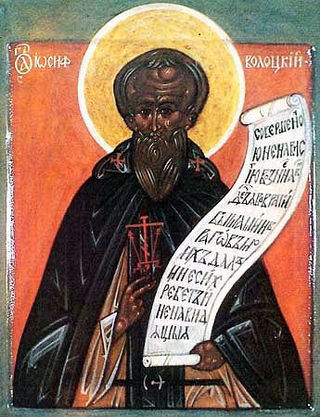
Joseph Volotsky — also known as Joseph of Volotsk or Joseph of Volokolamsk ; secular name Ivan Sanin — was a prominent Russian theologian and early proponent of tsarist autocracy, who led the party defending monastic landownership. The Russian Orthodox Church considers him a saint ; his memory is celebrated on 9 September and 18 October.
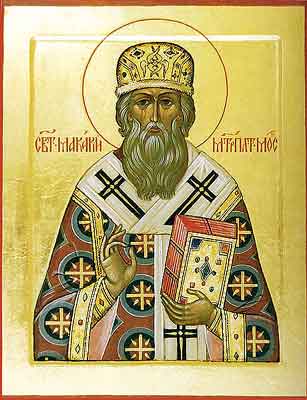
Macarius was the Metropolitan of Moscow and all Rus' from 1542 until 1563. He was the tenth metropolitan in Moscow to be appointed without the approval of the Ecumenical Patriarch of Constantinople as had been the norm.
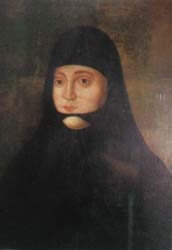
Solomonia Yuryevna Saburova was the grand princess of Moscow as the wife of Vasili III of Russia. She was canonized by the Russian Orthodox Church as Saint Sofia of Suzdal.
The Muscovite–Lithuanian Wars were a series of wars between the Grand Duchy of Lithuania, allied with the Kingdom of Poland, and the Grand Duchy of Moscow, which would later become the Tsardom of Russia. After several defeats at the hands of Ivan III and Vasily III, the Lithuanians were increasingly reliant on Polish aid, which eventually became an important factor in the creation of the Polish–Lithuanian Commonwealth. Before the first series of wars in the 15th century, the Grand Duchy of Lithuania controlled vast stretches of Eastern European land, from Kyiv to Mozhaysk, following the collapse of Kievan Rus' after the Mongol invasions. Over the course of the wars, particularly in the 16th century, the Muscovites expanded their domain westwards, taking control of many principalities.
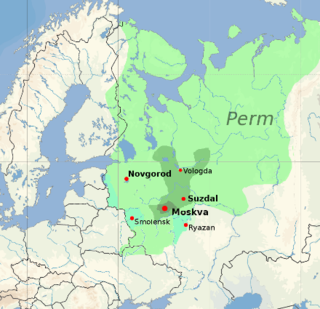
The Principality of Moscow or Grand Duchy of Moscow, also known simply as Muscovy, was a principality of the Late Middle Ages centered on Moscow. It eventually evolved into the Tsardom of Russia in the early modern period. The princes of Moscow were descendants of the first prince Daniel, referred to in modern historiography as the Daniilovichi, a branch of the Rurikids.

The Muscovite War of Succession, or Muscovite Civil War, was a war of succession in the Grand Duchy of Moscow (Muscovy) from 1425 to 1453. The two warring parties were Vasily II, the son of the previous Grand Prince of Moscow Vasily I, and on the other hand his uncle, Yury Dmitrievich, the Prince of Zvenigorod, and the sons of Yuri Dmitrievich, Vasily Kosoy and Dmitry Shemyaka. In the intermediate stage, the party of Yury conquered Moscow, but in the end, Vasily II regained his crown.
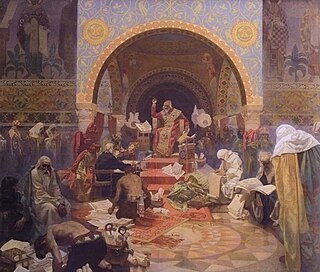
Tsar was a title used by Slavic monarchs. The term is derived from the Latin word caesar, which was intended to mean "emperor" in the European medieval sense of the term—a ruler with the same rank as a Roman emperor, holding it by the approval of another emperor or a supreme ecclesiastical official —but was usually considered by Western Europeans to be equivalent to "king". It lends its name to a system of government, tsarist autocracy or tsarism.
The Grand Prince of Vladimir, also translated as Grand Duke of Vladimir, was the title of the ruler of Vladimir-Suzdal, which was passed to the prince of Moscow in 1389.

















